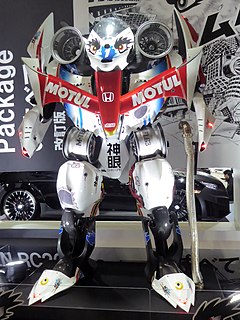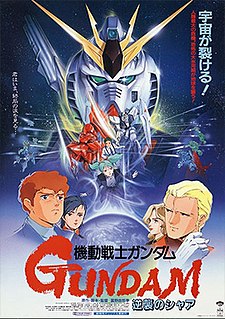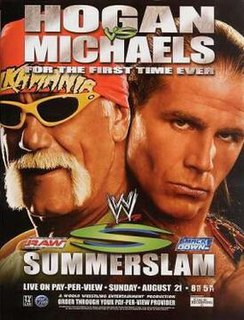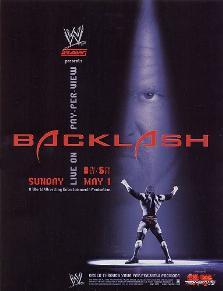
Mobile Suit Gundam, known in Japan as Kidō Senshi Gundam, is an anime television series, produced and animated by Nippon Sunrise. Created and directed by Yoshiyuki Tomino, it premiered in Japan on Nagoya Broadcasting Network and its affiliated ANN stations on April 7, 1979, and lasted until January 26, 1980, spanning 43 episodes. It was the first Gundam series, which has subsequently been adapted into numerous sequels and spin-offs. Set in the futuristic calendar year "Universal Century" 0079, the plot focuses on the war between the Principality of Zeon and the Earth Federation, with the latter unveiling a new giant robot known as the RX-78-2 Gundam piloted by the teenage civilian mechanic Amuro Ray.

The term mecha may refer to both scientific ideas and science-fiction genres that center on giant robots or machines (mechs) controlled by people. Mechas are typically depicted as humanoid walking vehicles. The term was first used in Japanese: 'mecha', after shortening the English loanword 'mechanism' or 'mechanical', but the meaning in Japanese is more inclusive, and 'robot' or 'giant robot' is the narrower term.

John Herbert Varley is an American science fiction writer.

Yoshiyuki Tomino is a Japanese mecha anime creator, animator, director, screenwriter, songwriter and novelist best known for creating the Gundam anime franchise. He was born in Odawara, Kanagawa Prefecture, and studied at Nihon University's College of Art.

Mobile Suit Gundam: Char's Counterattack is a 1988 Japanese animated science fiction film set in the Universal Century timeline of the Gundam franchise.

Anguirus is a fictional monster, or kaiju, which first appeared in Godzilla Raids Again (1955), the second film in the Godzilla franchise. Anguirus is the first monster to be shown engaging in combat with Godzilla in a film. Since then, the character has appeared conversely as an enemy and an ally of Godzilla in numerous films produced by Toho, including Destroy All Monsters, Godzilla vs. Gigan, Godzilla vs. Megalon, Godzilla vs. Mechagodzilla, and Godzilla: Final Wars. He has also appeared in other media, including comic books and video games.

David Michael Bautista Jr. is an American actor and former professional wrestler. He participated in WWE events from 2002 to 2010, in 2014, and one final run from 2018 to 2019. In his acting career, he is most widely known for his portrayal of Drax the Destroyer in the Marvel Cinematic Universe.
A leap is a jump or big step forward.

John Varley was an English watercolour painter and astrologer, and a close friend of William Blake. They collaborated in 1819–1820 on the book Visionary Heads, written by Varley and illustrated by Blake. He was the elder brother of a family of artists: Cornelius Varley, William Fleetwood Varley, and Elizabeth, who married the painter William Mulready.
Lynn Varley is an American comic book colorist, notable for her collaborations with her then-husband, comic book writer/artist Frank Miller.

The 2005 SummerSlam was the 18th annual SummerSlam professional wrestling pay-per-view (PPV) event produced by World Wrestling Entertainment (WWE). It was held for wrestlers from the promotion's Raw and SmackDown! brand divisions. The event took place on August 21, 2005, at the MCI Center in Washington, D.C. Nine matches were contested at the event, including one on the Sunday Night Heat pre-show.

Kidnapping, Caucasian Style is a 1967 Soviet comedy film dealing with a humorous plot revolving around bride kidnapping, an old tradition that used to exist in certain regions of the Northern Caucasus.
Drop Trio is a jazz band from Houston, Texas, consisting of Michael "Nuje" Blattel, Patrick Flanagan, and Ian Varley (keyboards)

Natalya Varley is a Soviet and Russian film and theater actress, who became famous in 1966 for her part in the comedy Kidnapping, Caucasian Style. In 1989 she was designated as a Meritorious Artist of RSFSR.

The 2005 Backlash was the seventh Backlash professional wrestling pay-per-view (PPV) event produced by World Wrestling Entertainment (WWE). It was held exclusively for wrestlers from the promotion's Raw brand division. The event took place on May 1, 2005, at the Verizon Wireless Arena in Manchester, New Hampshire. To date, it is the only WWE pay-per-view event to ever be held in the state of New Hampshire. The concept of the pay-per-view was based around the backlash from WrestleMania 21.

Akinori Tsukioka is a Japanese professional wrestler better known as Kuishinbo Kamen, a masked clown character. Kuishinbo Kamen is Japanese for "Gluttonous Mask". For a while he was forced to give up the Kuishinbo Kamen character, instead he worked as "Super Robo K", a futuristic Robot character, but returned to the Kuishinbo Kamen identity later on.

Space Gundam V is a South Korean animated film directed by Kim Cheong-gi, released on July 21, 1983. Despite its title, the series is not related to Mobile Suit Gundam. It is known for incorporating an unlicensed version of the VF-1J Valkyrie of Macross fame and the heroic elements of Brave Raideen.

A powered exoskeleton, also known as power armor, powered armor, powered suit, cybernetic suit, cybernetic armor, exosuit, hardsuit, exoframe or augmented mobility, is a mobile machine that is wearable over all or part of the human body, providing ergonomic structural support and powered by a system of electric motors, pneumatics, levers, hydraulics or a combination of cybernetic technologies, while allowing for sufficient limb movement with increased strength and endurance. The exoskeleton is designed to provide better mechanical load tolerance, and its control system aims to sense and synchronize with the user's intended motion and relay the signal to motors which manage the gears. The exoskeleton also protects the user's shoulder, waist, back and thigh against overload, and stabilizes movements when lifting and holding heavy items.
The Treasure Planet is a 1982 Bulgarian animated science fiction film directed by Rumen Petkov and produced by the Sofia Animation Studio. The 62-minute movie is a science fiction adaptation of Robert Louis Stevenson's 1883 adventure novel Treasure Island, and was released 20 years before Disney’s Treasure Planet, another movie with the same concept.

Creature suits are realistic costumes used to disguise a performer as an animal, monster, or other being. They are used in film, television, or as costumed characters in live events. Unlike mascots, they are often made with a high degree of realism. In contrast with prosthetic makeup, which is applied to an actor's skin, the wearer is not normally visible outside their movements controlling the costume, although in some cases, part of the wearer's body is still visible.
















